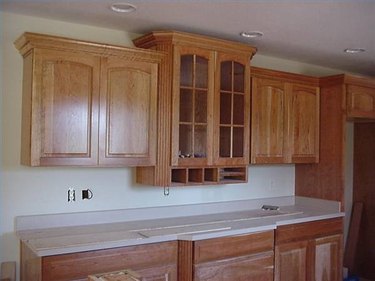Things You'll Need
Enough crown molding to span all your cabinets
Miter saw
Tape measure
Protractor for measuring the angles of corners

Cutting crown molding for topping kitchen cabinets tends to be easier than cutting it for walls, because, unlike most walls, the square angles on cabinets actually are square. It's a good idea to cut the corner angles first, then measure the rest to fit. As with crown molding on walls, the trick to cutting the angles is to position to the trim upside-down and backward on the miter saw.
Step 1
Starting at an outside corner of the cabinets, measure the span going to the right. Take a piece of molding larger than that measurement, lay it on your miter saw, on the left side of the blade. Position the piece so it's upside-down from the way it will go on the cabinets, the top edge sitting on the platform, the bottom edge propped back against the fence of the saw.
Video of the Day
Step 2
Turn the miter of the saw to 45 degrees right, so it's facing away from the trim. Slide the trim far enough to the right so the edge of it sits under the blade. Hold the trim so it's leaning back against the fence in the same way it will be leaning forward from the cabinet (remember, it's upside down right now). Make the cut.
Step 3
Cut the piece for the opposing (left) side of the same corner in the same manner, but set the piece on the right side of the blade and swivel the miter to 45 degrees left, away from the piece. The piece should be upside down and held at a backward slant as before. Make the cut.
Step 4
Hold the mitered ends of the two piece together to ensure they form a corner. Measure and cut the other ends of the pieces as needed to fit on the cabinets.
Step 5
Follow the same procedure for cutting inside corners, except turn the miter angle into the trim instead of away from it (i.e., if the trim is positioned on the left of the blade, turn the miter left, toward it, instead of right, away from it.)
Tip
If your inside corners aren't square, but are designed at a wider angle, use your angle protractor to get a reading, and use that reading for your miter angle in place of the 45 degree angle of a regular corner.
Warning
Wear protective goggles when using a miter saw.
Video of the Day